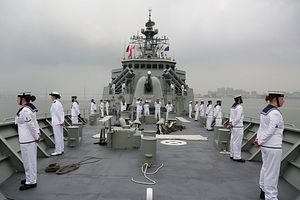It seems that the depth of the Pentagon’s angst surrounding the artificial islands in the South China Sea is not shared in the new Australian government or its naval circles. The Australian newspaper, by contrast, is trying to whip it up as usual by referencing incorrect and misleading statements about China. But there are bigger issues at play in the region that may force the island dispute to lose the heat that it has generated.
The Australian government has followed its U.S. ally by asserting correctly that warships enjoy the right of unimpeded freedom of navigation in water areas outside of the territorial sea of other countries. This seems to be the overwhelming weight of opinion on all sides in Australia. One of the best and calmest articulations of this was an article by retired Admiral James Goldrick in the Lowey Interpreter on 29 October (“Why Australia must send its navy to assert the freedom to operate in the South China Sea”). He counselled:
The operation should be conducted without warning and it should not be a matter for an immediate press release. We need to be restrained in the publicizing of our activities.
This tone of restraint is indeed welcome, as other Australia naval specialists, such as retired Commodore Sam Bateman, have also counseled (See: “Why US South China Sea FON Operations Don’t Make Sense”).
Implicit in these wise words from two of the country’s wisest men of naval strategy is a clear-eyed assessment of what is at stake. Neither see a threat to commercial shipping from China as a likely consequence of the current development of artificial islands on reefs that China first occupied beginning in 1988 and which it first claimed before Japan annexed them in 1939.
By contrast, The Australian newspaper on October 31, as if on cue, lined up in a full page spread of several authors with remarkably coincident views on how the actions by China were a more serious threat. They strongly advocated that Australia follow the U.S. lead in confronting China. Each of these articles contained important errors or misleading statements of fact, and all seemed strangely oblivious to reality.
For me, the overwhelming reality for China, and one rarely mentioned, is that it depends on the safety of commercial shipping through the South China Sea at least as much as either the United States or Australia. Moreover, many of the Australian goods carried across the area are traded with China in Chinese ships (See: “Why China Poses No Threat to South China Sea Commerce”).
To put the two contesting camps in Australia into perspective, the news reports were live by Monday November 2 with accounts of the planned joint exercises between the Australian navy and its Chinese counterpart. What was even more remarkable was that the Australians would be exercising with the South Sea Fleet which has operational responsibility for the South China Sea all the way to the southern tip of Taiwan.
In what could only be described as a hallmark Australian understatement, in contrast to the megaphone diplomacy of the United States Navy, the captain of one the Australian navy ships in China was quoted as follows: “It’s business as usual for us. We’re not here to do anything with that [freedom of navigation]”, according to the ABC. “It makes no difference what’s going on with that,” continuing “We’re here to do a job and get on and build that relationship and our understanding with the PLAN [People’s Liberation Army Navy].”
In spite on hand wringing in Australia about the dilemmas between Australia’s strategic interests in lining up with the United States confrontational stance or those of being conciliatory to China for economic interests, the laconic responses of the Australian naval officer say all that needs to be said. Polite but firm diplomacy is adequate for the military problem at hand, which for Australia is exclusively one of freedom of navigation of navy ships and aircraft outside the territorial sea.
Another development in East Asia over the weekend helps put the spat in the South China Sea in perspective. This was the China-Japan-Korea summit meeting, the first since 2012 when rising tensions over the Senkaku Islands dispute derailed what was becoming a major foundation of regional peace, stability and prosperity. This is not the place for a detailed analysis of that important (and complex) set of relationships. Suffice it to be remarked here that in comparison with the real threats and great opportunities in international relations of East and Southeast Asia, the Spratly Island disputes are exactly as described once by former Chinese foreign Minister, Yang Jiechi, “small in scale and local nature”.
By the time the next U.S. President is inaugurated, in January 2017, it is probably safe to bet that the current Spratly spat will have been papered over. China needs us as much as we need China. We all need peace in the South China Sea. China is not our enemy.

































